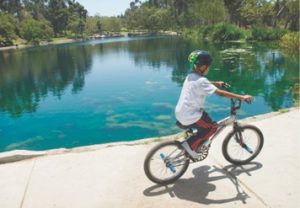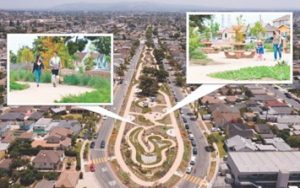Los Angeles County‘s Safe Clean Water Program (SCWP) is a one-of-a-kind initiative of the Los Angeles County Flood Control District (District), managed by Los Angeles County Public Works, that invests approximately $280 million annually into multi-benefit stormwater capture projects and programs. The SCWP is designed to clean and conserve billions of gallons of stormwater that would otherwise be lost to the ocean when it rains, and to do so in a manner that improves the livability and resilience of LA County’s communities through development of green space, recreational opportunities, and other enhancements, as able. The SCWP strongly promotes and facilitates regional collaboration while prioritizing investments in disadvantaged communities and the utilization of nature-based solutions. The success of both the collaborative development and collaborative implementation have made SCWP a model for others across the country.

SWCP projects improve water quality, increase water supply, and do so in a way that improves the quality of life for LA County communities.
Like other California regions, LA County navigates an array of complex water resilience challenges, including polluted waterways, the impacts of climate change (such as more frequent and severe droughts), limited and aging infrastructure, and a dependence on imported water. Additionally, the County and the 86 municipalities within it are mandated to develop infrastructure projects to improve stormwater quality and reduce pollution as part of the region’s compliance with the Federal Clean Water Act.
These are regional issues requiring a regional approach.
Much of LA County is covered in impermeable area – i.e., surfaces such as rooftops, parking lots, and roads where water cannot soak into the ground. This can create flooding as well as the loss of potential local water supplies. Additionally, when water hits these surfaces, it runs off, often collecting trash and pollutants that flow, untreated, into the region’s rivers, lakes, streams, and the Pacific Ocean. Capturing and cleaning up this stormwater is difficult and expensive.
In 2018, LA County residents voted to approve a ballot measure, Measure W, that created the SCWP and allowed for the collection of a special parcel tax of 2.5 cent ($0.025) per square foot of impermeable area. This tax is levied on more than 2.1 million parcels within the District’s boundary and generates a dedicated revenue source to help address the above water resilience challenges. Robust tax relief options were also built into the SCWP for qualifying parcel owners, including low-income senior exemptions, other income-based reductions, and credits.
SAFE CLEAN WATER PROGRAM
 SCWP revenue, collected annually, is managed by the District and allocated across three programs: 50 percent for a Regional Program to support regional projects and studies, 40 percent for a Municipal Program that returns funds directly to municipalities in proportion to the taxes collected within their jurisdiction, and 10 percent for a District Program that supports public education and engagement, curriculum for local schools, workforce development, and overall SCWP management and oversight.
SCWP revenue, collected annually, is managed by the District and allocated across three programs: 50 percent for a Regional Program to support regional projects and studies, 40 percent for a Municipal Program that returns funds directly to municipalities in proportion to the taxes collected within their jurisdiction, and 10 percent for a District Program that supports public education and engagement, curriculum for local schools, workforce development, and overall SCWP management and oversight.
The SCWP Regional Program includes governance committees that are composed of a diverse set of participants including subject matter experts in water quality, water supply, community investment, and nature-based solutions. There are representatives from cities, water agencies, sanitation agencies, parks agencies, environmental groups, environmental justice advocates, community-based organizations, academia, business leaders, and members of the public. Committee members vet each project seeking SCWP funds and recommend those that best support SCWP goals and the priorities of the area.
For the Regional Program to date, 78 multi-benefit infrastructure projects, 38 project concepts, and eight scientific studies have been approved for funding. This represents over $570 million in investments ($385 million benefitting disadvantaged communities) over five years, which, when completed, will capture stormwater runoff from over 207,000 acres. Additionally, these investments leveraged another $480 million from other funding sources to maximize SCWP goals. Further information about the planned and funded projects is available online (https://portal.safecleanwaterla.org/scw-reporting/dashboard). These numbers will continue to grow with each annual cycle and the next set of investments (bringing the infrastructure project count to 102) is anticipated to be approved in October 2022.
The Municipal Program 40 percent local return is distributed annually to the 86 municipalities within the District boundaries. This funding is utilized by the municipalities for development of their own local multi-benefit stormwater capture projects and programs and may be used to contribute to regional-scale projects. Annual Plans and Annual Reports are available on the webpage to demonstrate how each municipality is pursuing SCWP goals within their jurisdiction.
WATER RESILIENCE PROJECT EXAMPLE

East LA Median Project: The Los Angeles County Flood Control District’s Safe Clean Water Program, funded by a voter-approved special parcel tax, is designed to capture and clean stormwater to increase water supply. The projects in parks and medians, as illustrated here, are spread across the 86 county municipalities and benefit many disadvantaged communities. In addition to providing more water for residents, the projects create green spaces for recreation and improve the quality of life in the region
The City of Inglewood’s Edward Vincent Junior Park Stormwater Capture Project benefits a Disadvantaged Community and already has strong community support. Located in the park, the proposed project would divert flows from three existing storm drains to a large infiltration chamber, restore a creek, and include a vegetated bioretention area at the low-lying end of the park where nature is used to filter polluted stormwater. It would also install above-ground park amenities such as enhanced ball field space, seating, shade, walking trails, and educational signage.
This project first received SCWP funding through the Regional Program’s Technical Resources Program, a program intended to assist small municipalities, community-based organizations, non-governmental organizations, and others who may not have the technical resources to develop the Feasibility Study that is required for project proposals.
Following the completion of the Feasibility Study, the City of Inglewood applied for $4.3 million in design funding. After the proposal was thoroughly reviewed, discussed at public meetings, and ultimately recommended for approval by the governance committees, it is now anticipated for Board approval in October 2022.
This project, like those approved before it and those still to come, will continue to improve the quality of life for LA communities. It’s a testament to the region’s commitment to achieving water resilience collaboratively and strategically – and an example for others looking to achieve similar goals. Please visit safecleanwaterla.org to track benefits as they continue to unfold and to learn more about getting involved!

